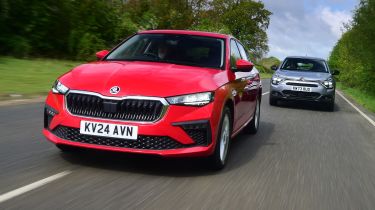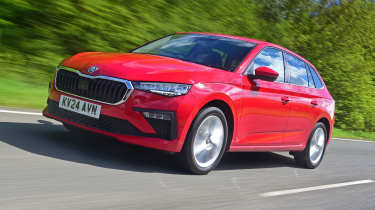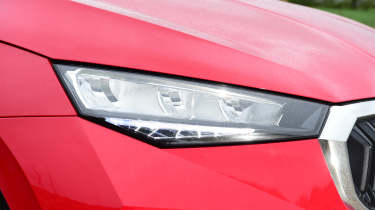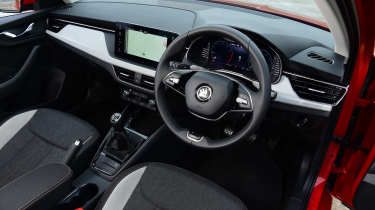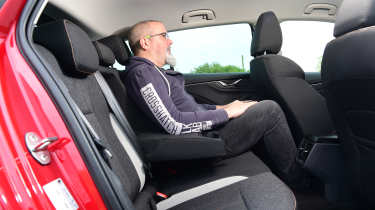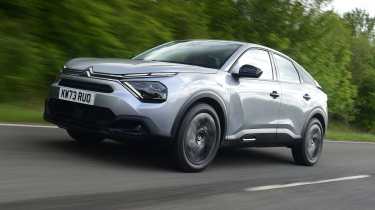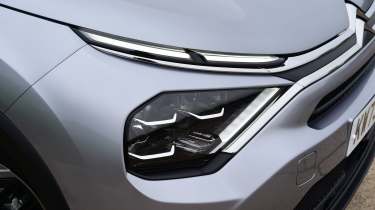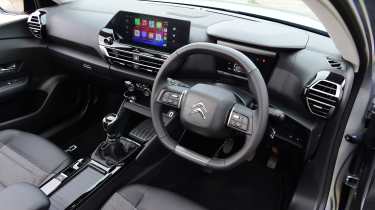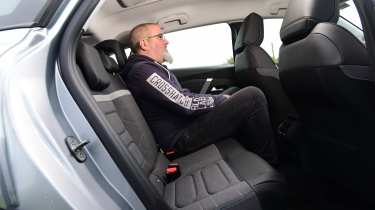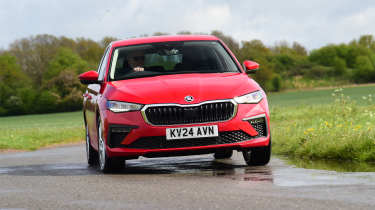Skoda Scala vs Citroen C4 2024 twin test: which is the best-value family hatchback?
The revised Skoda Scala takes on Citroen’s C4 in the battle to be the best-value family hatchback
The cost of living crisis means that people are trying to make their money go further, and when it comes to cars – often an essential purchase even when finances are tight – a budget hatchback could offer the best mix of low running costs and family-friendly versatility.
One firm that was once a go-to brand for the budget conscious is Skoda. While it was a champion of cheap motoring in the eighties and nineties, most of its models have moved upmarket, but the Scala is a car that still has value for money in its arsenal of strengths.
In an effort to maintain its appeal, Skoda has given the Scala an update, with more kit and a few more premium touches that mean it’s not as humdrum as its price tag would suggest.
Another maker with the economical customer in mind is Citroen. It launched the budget-minded C3 You! last year, but it has now introduced a variant to the C4 line-up which limbos under the £20,000 mark.
There’s no electrification here, with both cars powered by three-cylinder turbocharged petrol engines, and they both feature another rarity of the new-car market, because they’re paired with manual gearboxes.
Used - available now

2023 Honda
Jazz
8,359 milesAutomaticPetrol1.5L
Cash £16,995
2023 Ford
Kuga
21,659 milesAutomaticPetrol2.5L
Cash £21,697
2023 Skoda
Kamiq
17,635 milesManualPetrol1.5L
Cash £15,197
2021 MINI
Cooper Electric
24,423 milesAutomaticElectric
Cash £12,697We’ll be focusing on practicality and economy for these two models, as we work out which one offers the best value for money in a family-friendly hatchback package.
| Skoda Scala 1.0 TSI 95 SE | Citroen C4 PureTech 100 You! | |
| Price: | £22,105 | £19,720 |
| Powertrain: | 1.0-litre 3cyl turbo petrol, 94bhp | 1.2-litre 3cyl turbo petrol, 99bhp |
| 0-62mph: | 10.8 seconds | 10.8 seconds |
| Test efficiency: | 47.2mpg/10.4mpl | 48.3mpg/10.6mpl |
| CO2: | 117g/km | 124g/km |
| Annual VED: | £190 | £190 |
Skoda Scala
With the Octavia growing in size and prestige with every generation, Skoda needed a new budget-minded hatchback. First came the Rapid Spaceback in 2013, and this was succeeded by the Scala in 2019. The facelifted version has just been launched, and we’re testing the entry-level SE here, although the car in our pictures is in SE L trim.
Tech highlights
The Scala was designed as a budget-minded hatchback from the outset, and to help keep costs down, it uses existing technology from within the Skoda line-up, chiefly from the Fabia supermini. It’s based on the same MQB A0 platform, but is 254mm longer, 13mm wider and has a wheelbase that’s stretched by 85mm, making it one of the larger cars to use this version of MQB. As a result, it’s similar in size to the Citroen here.
As well as using the same platform as the Fabia, it shares engines and gearboxes, too, with a petrol-only line-up and a choice of manual or automatic transmissions. The infotainment system is carried over, too, with digital dials and a touchscreen, while the Scala’s facelift added a new steering wheel. It’s the two-spoke item from the Fabia, and it features a more stylish pair of knurled rotary controls than before.
Other updates as part of the facelift include a slimmer headlight design, with the option of matrix LEDs now available, sustainable cabin materials, more practical touches and greater efficiency and power from the engine range.
Safety: The original Scala’s five-star Euro NCAP rating from 2019 still applies. Additions with the update include Early Light Assist, which automatically turns them on in low light, while Assisted Drive with predictive adaptive cruise and lane assist is available for £800 extra.
On the road
What the Scala lacks in power it more than makes up for with grown-up driving manners.
Around town: Rear parking sensors are fitted as standard on the Scala SE, although the car’s hatchback body and large windows mean all-round visibility is good enough that you don’t have to rely on them when manoeuvring.
The steering has plenty of assistance at low speeds, while the 1.0-litre three-cylinder engine makes 175Nm of torque from 1,600rpm, so the Scala is quick enough to keep pace with traffic, but not a lot else. At least the manual gearbox has a positive shift that helps you work through the ratios.
The car’s ride is well resolved on the SE L’s 17-inch wheels, with only the biggest potholes sending shudders through the cabin, so the 16-inch alloys that are fitted as standard on SE models should deliver even greater comfort.
A & B-roads: With only 94bhp on tap, the Scala’s performance isn’t going to set the world on fire, but a 0-62mph time of 10.8 seconds matches the C4 here, while the slick-shifting gearbox means it’s more enjoyable to try and make the most of what little power the Skoda has to offer.
The Scala’s chassis is better resolved than its rival’s, too, with the suspension delivering greater control in corners. When loaded up, the springs and dampers aren’t upset by mid-corner bumps as they are in the Citroen, so the Skoda feels stable and more sure-footed as a result.
Motorway: The Scala is fine at higher speeds, but if you’re going to do a lot of motorway miles, we’d recommend upgrading to the 115bhp 1.0 TSI with the six-speed manual. The 94bhp version isn’t harsh, but you’ll benefit from improved refinement.
Ownership
From behind the wheel, the Scala has the same solid feel as other Skoda models that has seen the brand edge close to parent firm VW in terms of build quality. The layout is more functional than stylish, and some of the plastics on the dashboard and doors are hard, but the important touchpoints feel good, and while there are plenty of black and charcoal-coloured materials used, a lighter headlining means it’s not oppressive.
The cabin layout is logical, and easy to get along with, but there’s a semi-physical set-up for the dual-zone climate control system; you can adjust the temperature via rotary knobs as before, but these have been joined by buttons that change the fan speed. However, you still need to call up the climate control menu on the touchscreen to do anything else, such as selecting air vents.
While Skoda was once a front-runner in our Driver Power ownership surveys, it has slipped in the rankings of late. The company finished 20th out of 32 manufacturers last year, with Citroen ending up 11th in the same survey. Both cars here come with a fairly standard three-year/60,000-mile warranty, although Skoda offers extended cover for up to five years at extra cost. There’s 12 months of roadside assistance for both cars, too.
Storage: A Skoda wouldn’t be a Skoda without a bunch of practical storage solutions, and the Scala offers plenty of useful touches. The front door bins are long and high-sided, the glovebox is a decent size and shape, and while the centre armrest bin is square, it’s deep. Ahead of that are a trio of cup-holders – two large, one small – that overlap each other, while the one furthest forward has a grippy bottom that’s designed to help you open a screwtop bottle with one hand. Ahead of the gearlever is a deep storage space that’s suitable for smartphones and has two USB-C sockets. There are two more USB-Cs for the back seats, too.
Practicality
The Scala offers decent interior space and a big boot suitable for family life.
Rear space: The Scala is broad across the back and there is room for three to sit in reasonable comfort. Rear air vents and USB sockets are fitted, while the centre seat back folds to reveal an armrest equipped with two cup-holders.
Kneeroom is good, but the transmission tunnel is taller than the C4’s, so middle-seat passengers are compromised a little.
Boot: At 467 litres the Scala’s boot is bigger than in many other hatchbacks, and it comes with a low load lip, too. There are four hooks on either side and two more on the rear seat backs, while a long plastic grab handle attached to the inside of the bootlid means it’s easy to shut. Fold the seats, and slots in the plastic trim on either side keep the seatbelts out of the way so they don’t get trapped in the mechanism.
Which to buy
Which version we’d choose…
- Engines: There are 1.0 TSI and 1.5 TSI engines to choose from, the former a three-cylinder with either 94bhp or 115bhp, while the latter has 148bhp. Manual gearboxes are standard, while the two more powerful engines can be had with a seven-speed DSG auto.
- Trim: Three trim levels are offered: SE, SE L and Monte Carlo, although the latter isn’t offered with the 94bhp petrol. SE L adds fabric trim to the dashboard, a larger Virtual Cockpit and bigger touchscreen with navigation, while Monte Carlo features a sportier look and a Sport driving mode.
- Our choice: The 116bhp 1.0 TSI has a bit more poke, but SE trim has all the kit you need.
Citroen C4
You! is Citroen’s budget-focused trim, which first arrived on the C3 supermini. Now there’s a C4 variant that offers some decent kit at a knock-down price. It starts from less than £20,000, at £19,720, while only a limited number of options are available to bump the price any higher.
Tech highlights
As with the Skoda, the Citroen C4 uses a scaled-up supermini platform as its base, in this instance the EMP1 system created by PSA Peugeot Citroen and subsequently used by a wide range of models within the larger Stellantis group.
The C4 mirrors the Scala in that it’s one of the biggest cars to use its platform. Stellantis’s Peugeot 308 and Vauxhall Astra are a similar size, but are based on the more sophisticated EMP2 architecture. This has helped Citroen to keep costs down, while the C4’s engine range and cabin tech are also shared with numerous other models, just like Skoda has done with the Scala.
One area where these two cars diverge is in terms of design. While the Skoda is a basic five-door hatchback, the C4 is being promoted as a crossover, with angular styling, SUV-inspired black-plastic cladding and a raised ride height. It sits 54mm taller than the Skoda, while a short rear overhang and coupé-style roofline give it a distinctive look.
Chassis: The C4 and Scala are conventional in terms of suspension set-up, with both featuring cost-effective MacPherson-type struts up front and a torsion beam at the rear. However, the Citroen also comes equipped with Advanced Comfort Suspension, a set-up that adds a pair of hydraulic stops for each damper that are designed to smooth out the car’s ride. The system isn’t as advanced as the hydropneumatic set-up that Citroen has used in the past, but it’s a budget solution that boosts the C4’s ability.
On the road
The C4 offers comfort and a punchy petrol engine, but the rest of the experience is disappointing.
Around town: The Advanced Comfort system does a good job of ironing out bumps, and the C4’s raised ride height and bigger tyres when compared with the Skoda contribute to this feeling.
The torquey petrol engine does its best work at urban speeds, too, with decent pull from low revs. If only the gearbox were as responsive. While the six-speed transmission offers greater flexibility than the Skoda’s five-speed unit, the shift is vague and rubbery, and the lever doesn’t feel very positive as it slots home. The brake pedal feels a little soft under foot, too, although there’s no issue with the braking performance that’s on offer.
A & B-roads: Pick up speed and the C4’s comfort-biased character shines through. The soft edge to the ride means the Citroen is at its best when cruising, while the slack gearshift also discourages you from pressing on. However, it’s still a better option than Citroen’s hesitant auto.
In corners there’s plenty of roll as the C4 leans on its suspension, while the whole car bobs up and down when traversing mid-corner bumps; the Skoda is rock solid over similar lumps in the road. The steering offers limited feedback, but while grip is good, the car is firmly biased to understeer and washes out sooner than the Skoda when you explore its limits.
Motorway: The Citroen is an adept long-distance cruiser, courtesy of its comfortable suspension and that six-speed gearbox, which helps to keep the revs low at motorway speeds. There’s not as much wind noise as you’ll find in the Scala, while thumps from the suspension are only felt in the cabin when large potholes are hit.
Ownership
While the C4’s exterior is quite radical when compared with the restrained Skoda Scala, things are much more conventional from behind the wheel. The cabin features a lot of hard plastic, with gloss-black trim around the air vents, on the centre console and for the thick lower spoke on the steering wheel.
Cabin quality is good, though, with a solid feel for all materials, while the seats are trimmed in grey fabric with fake leather for the front of the seat bases and across the shoulders. The seat cushions are soft, further emphasising the C4’s bias towards comfort, although they’re not so squidgy as to cause discomfort on longer trips.
The car’s shape does impact visibility from behind the wheel, though, especially over the shoulder and out of the rear window.
The Citroen C4 has proved to be a hit with buyers, and in the 2023 Driver Power survey, positive feedback from owners placed it at number one in the model rankings. Owners are fans of the car’s smooth ride, while its fuel economy, low running costs and user-friendly safety features also came in for praise. The only real negatives related to the touchscreen and visibility from the driver’s seat.
Storage: The C4’s door bins are small when compared with the Scala’s, the armrest bin is awkwardly shaped, and ahead of it are two simple cup-holders beneath a sliding cover. In front of the gearlever are two shelves, and the lower one flips up to reveal another cubby, although the hinged shelf is only loosely attached, so it pops off when you lift it.
The C4’s glovebox suffers from the usual fusebox intrusion that’s common with many cars that switch from left to right-hand drive. But there is additional storage above, courtesy of a pop-out tray that’s big enough for A4-sized documents or devices, while above that is a removable panel that hides a mounting bracket for a tablet.
Practicality
Space is a bit tighter here than it is in the Scala, thanks to the C4’s shape.
Rear space: While the C4’s is slightly wider than the Skoda, it has less space in the back. Headroom is tighter, and the middle chair is compromised. It’s so narrow that there’s no folding armrest, although a flatter transmission tunnel means foot space is fine. There are two sets of Isofix child-seat mounts hidden behind zipped covers; the Scala’s are more easily accessible and are supplemented by another pair on the front passenger seat.
Boot: The C4’s taller ride height means it’s harder to lift items in and out, but the black-plastic bumper trim will resist knocks better than paint. There are only two small hooks on either side of the boot, while a capacity of 380 litres is average for the class. Fold the seats and there’s 1,250 litres of space and a step in the floor.
What to buy?
Which version we’d choose…
- Powertrains: The petrol line-up uses the 1.2 PureTech three-cylinder with 99bhp or 129bhp, while the latter is available with an eight-speed auto as well as the six-speed manual. The recently introduced 134bhp Hybrid uses the same engine and includes a six-speed twin-clutch auto.
- Trim: You! trim tested here undercuts the rest of the range by £4,000, but only comes with the PureTech 100 engine. Plus and Max specs kick off with the PureTech 130, while adding the auto ’box bumps the price up by £1,410. The hybrid is another £1,340 on top of that.
- Our choice: The C4 You! is good value and has enough power to be usable every day.
Results
Which car comes out on top?
Winner: Skoda Scala
If you’re after a no-nonsense five-seat family hatchback that gets the job done with zero fuss, then the Skoda Scala is a perfect fit. Even in SE trim, it doesn’t feel like a basic model, while the driving experience edges it ahead of the C4 here.
The entry-level 1.0 TSI is a little underpowered, so if you can afford the extra, we’d recommend the 115bhp version instead, especially because it comes with a six-speed gearbox. But either way, this is a compact hatch that should deliver low running costs.
| Pros: | Cons: |
| Decent kit list | Average performance |
| Solid driving manners | Nondescript styling |
| Lots of space | Pricey option packs |
| Slick gearshift | Needs a six-speed gearbox |
Runner-up: Citroen C4
There’s plenty to like about the Citroen C4. The cabin feels upmarket, it’s comfortable and it has some practical touches that would make Skoda proud. This entry-level You! model makes the rest of the range look pricey, while the punchy petrol engine belies its low power output.
We just wish the C4 were a bit more polished. Spongy controls and a wallowy ride mean it has to give second best to the Scala here, but it’s still a great-value choice.
| Pros: | Cons: |
| Comfortable seats | Woolly manual gearbox |
| Soft ride | Wallowy in corners |
| Torquey petrol engine | Vague steering |
| Efficient | Smaller inside than Scala |
Rivals and other options
The Scala wins our test, but what else is out there?
- Same class: Kia Ceed
- Same money: Dacia Jogger
- Used: Ford Focus
- Used: Skoda Octavia
- Coming soon: Volkswagen Golf
The great debate
The Auto Express team have their say…
John McIlroy, editor-at-large: “Citroen’s take on the C4 is very refreshing; it’s accepted that most buyers don’t pick cars like these for sharp handling, so it instead has gone the other way and delivered great comfort instead. I wish more makers considered ride quality a bigger priority than they currently do.”
Richard Ingram, deputy editor: “It isn’t just the petrol-powered C4 that’s a bit of a bargain – the e-C4 is among the most keenly priced options in the class, too. Prices start from £32,410 for the You! trim, which benefits from the same soothing C4 road manners, but with a 134bhp e-motor and 50kWh battery.”
Dawn Grant, picture editor: “If you don’t quite need all of the space that the Scala promises, then one step down the range to the Fabia might be just for you. For a relatively small car, the Fabia feels incredibly grown up, thanks to its great refinement and relaxing ride. It’s still got plenty of room inside and a big boot.”
Jordan Katsianis, senior staff writer: “Citroen has never been a brand to shy away from unique designs, and the C4 is no different. We’ll leave you to draw your own conclusions on how pretty it is, but it’s nice to see that Citroen is still trying to do something different in an otherwise generic segment.”
Alex Ingram, chief reviewer: “I’m quite fond of the C4 and I’m fully behind its comfort approach, but soft suspension shouldn’t be an excuse to make every other control vague and woolly too. If Citroen put a little more effort into fixing the vague steering and sloppy gearbox, it’d be my ideal hatch.”
Which would you buy? Let us know in the comments section below…
Specs and prices
| Skoda Scala 1.0 TSI 95 SE | Citroen C4 PureTech 100 You! | |
| On the road price/total as tested: | £22,105/£22,105 | £19,720/£20,315 |
| Residual value (after 3yrs/36,000): | £10,765 (48.7%) | £9,130 (46.3%) |
| Depreciation: | £11,340 | £10,590 |
| Annual tax liability std/higher rate: | £1,222.48 | £1,127.81 |
| Annual fuel cost (10k/20k miles): | £1,732 (£2,887) | £1,693 (£2,822) |
| Ins. group/quote/VED: | 12/£1,102/£190 | 14/£1,242/£190 |
| Length/wheelbase: | 4,362/2,649mm | 4,360/2,670mm |
| Height/width: | 1,471/1,793mm | 1,525/1,800mm |
| Engine: | 3cyl in-line turbo petrol/999cc | 3cyl in-line turbo petrol/1,199cc |
| Peak power: | 94bhp/5,000rpm | 99bhp/5,500rpm |
| Peak torque: | 175Nm/1,600rpm | 205Nm/1,750rpm |
| Transmission: | 5spd manual/fwd | 6spd manual/fwd |
| Fuel tank capacity: | 52.5 litres | 50 litres |
| Boot capacity (seats up/down): | 467/1,410 litres | 380/1,250 litres |
| Kerbweight/payload/towing weight: | 1,179/421/1,000kg | 1,209/481/1,000kg |
| Turning circle/spare wheel: | 10.2 metres/£150 | 10.9 metres/repair kit |
| Basic warranty (miles)/recovery: | 3yrs (60,000)/1yr | 3yrs (60,000)/1yr |
| Driver Power manufacturer position: | 20th | 11th |
| Euro NCAP: Adult/child/ped./assist/stars: | 97/87/81/76/5 (2019) | 80/83/57/63/4 (2021) |
| 0-62mph/top speed: | 10.8 seconds/119mph | 10.8 seconds/114mph |
| Auto Express economy/range: | 47.2/545 | 48.3/531 |
| WLTP combined: | 54.9mpg | 54.6mpg |
| Actual/claimed CO2: | 138/117g/km | 135/124g/km |
| Number of airbags/Isofix points: | Seven/three | Six/two |
| Parking sensors/camera: | Rear/£1,000 Convenience Pack | Rear/£180 |
| Lane-keep assist/blindspot/AEB: | Yes/no/yes | Yes/no/yes |
| Climate control/adaptive cruise: | Two-zone/£800 | Two-zone/no |
| Leather/heated seats/wheel: | **/£295 Winter Pack/£595 Winter Premium | No/no/no |
| Metallic paint/adaptive LED lights: | £660/yes | £595/yes |
| Keyless entry & go/powered tailgate: | £1,000/no | No/no |
| Sat-nav/digital dashboard/USBs: | No/yes/four | No/yes/three |
| Online services/wireless charging: | Yes/£350 Charging Package | No/no |
| Apple CarPlay/Android Auto: | Wireless/wireless | Wireless/wireless |

